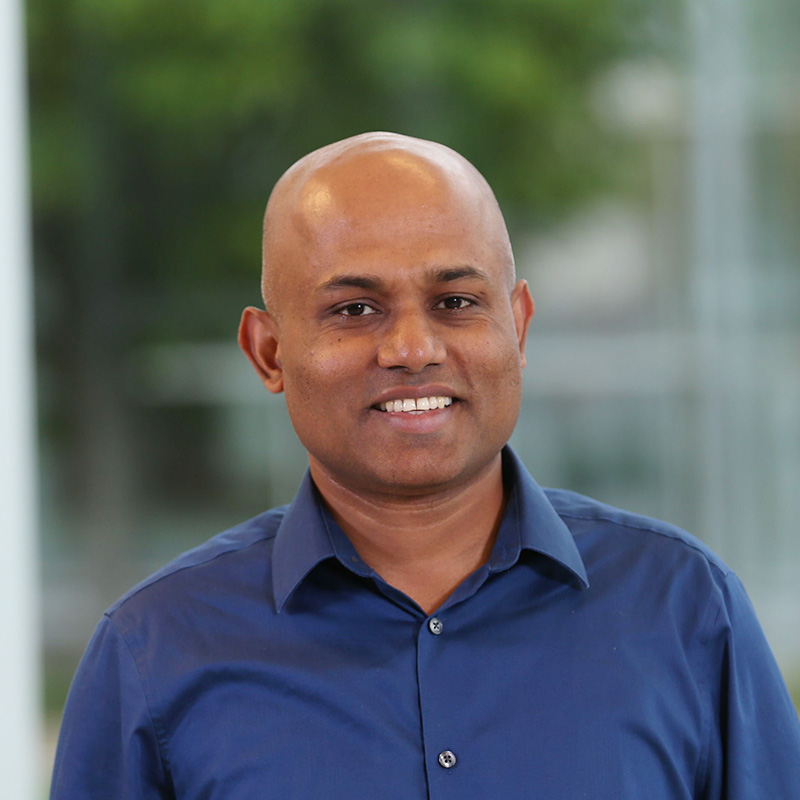
Sujith Puthiyaveetil

Assistant Professor of Biochemistry
Ph.D., Queen Mary University of London
spveetil@purdue.edu
765-494-8339
BCHM 305A
https://ag.purdue.edu/biochem/PuthiyaveetilLab/
Chromatin and Regulation of Gene Expression
Membrane Biology
Plant Biology
Active Mentor - currently hosting PULSe students for laboratory rotations and recruiting PULSe students into the laboratory; serves on preliminary exam committees
Current Research Interests:
The regulated synthesis and degradation of proteins produce homeostasis in the functional proteome of the cell (proteostasis). Chloroplasts are subcellular compartments in which photosynthesis, the conversion of light energy into chemical energy, takes place in plants and algae. Plant chloroplasts spend nearly 70% of the ATP budget set aside for synthesis and degradation of cellular proteins. This staggering energetic cost of plastid proteostasis arises from the high abundance and turnover of photosynthetic proteins, as dictated by the need to harvest a dilute and dangerous source of energy – sunlight. Strategies that ensure economical protein synthesis in plastids are therefore of outmost importance to photosynthetic efficiency, the energy balance sheet of the cell, and plant health. However, relatively little is known about the contribution of regulated protein synthesis in plastid proteostasis. We investigate the role of a bacterial-type gene regulatory protein termed Chloroplast Sensor Kinase (CSK) in plastid proteostasis. Our recent research shows that CSK employs an iron-sulfur cluster to perceive and propagate the photosynthetic electron transport signal to plastid gene expression machinery. We use system biology approaches in the model plant Arabidopsis to test the proposed plastid proteostasis function of CSK. Photosystem II (PS II) carries out the formidable water-splitting reaction in photosynthesis and thereby extracts electrons and protons necessary for the anabolic reactions of life. Incomplete water-splitting and or inadvertent electron transfer to molecular oxygen generate highly reactive oxygen free radicals that damage a key protein subunit in PS II. PS II repair cycle is a highly orchestrated molecular process wherein the damaged PS II subunit is selectively degraded and replaced with a newly synthesized copy. Using biophysical and biochemical approaches we investigative the role of post-translational modifications in the repair cycle of PS II.
Diatoms are a group of mostly aquatic photosynthetic algae with a plastid of red algal origin. These prolific photosynthesizers, while constituting just a fraction of the total biomass on earth, fix as much carbon as all rainforests combined. We use the model diatom Phaeodactylum tricornutum to decipher the genetic basis of diatoms’ high photosynthetic light use efficiency. Our recent research finds evidence for regulation of plastid genes in diatoms. In Phaeodactylum the expression of multiple plastid genes seem to be under the control of the redox state of plastoquinone (PQ), an electron carrier that links the two photosystems. We currently study the physiological significance of PQ-redox responsive plastid gene expression and its underlying regulatory circuitry in diatoms.
Selected Publications:
Puthiyaveetil S, Kayanja G, McKenzie SD, Ibrahim IM (2021) Transcription initiation as a control point in plastid gene expression. BBA - Gene Regulatory Mechanisms 1864(3): 194689.
Kayanja G, Ibrahim IM, Puthiyaveetil S (2021) Regulation of Phaeodactylum plastid gene transcription by redox, light, and circadian signals. Photosynthesis Research 147, 317-328.
McKenzie SD, Ibrahim IM, Aryal UK, Puthiyaveetil S (2020) Stoichiometry of protein complexes in plant photosynthetic membranes. BBA - Bioenergetics 1861(2): 148141.a
Ibrahim IM, Wu H, Ezhov R, Kayanja G, Zakharov S, Du Y, Tao WA, Pushkar Y, Cramer WA, Puthiyaveetil S (2020) An evolutionarily conserved iron-sulfur cluster underlies redox sensory function of the Chloroplast Sensor Kinase. Commun Biol 3(1):13.
Macadlo LA, Ibrahim IM, Puthiyaveetil S (2020) Sigma factor 1 in chloroplast gene transcription and photosynthetic light acclimation. J. Exp. Bot. 71(3): 1029-1038.
Koochak H, Puthiyaveetil S, Mullendore D, Li M, Kirchhoff H (2019) The structural and functional domains of plant thylakoid membranes. Plant J. 97(3): 412-429.
Puthiyaveetil S, van Oort B, Kirchhoff H (2017) Surface charge dynamics in photosynthetic membranes and the structural consequences. Nat Plants 3, 17020. doi: 10.1038/nplants.2017.20.
Puthiyaveetil S, Tsabari O, Lowry T, Lenhert S, Lewis RR, Reich Z, Kirchhoff H (2014) Compartmentalization of the protein repair machinery in photosynthetic membranes. Proc. Natl. Acad. Sci. USA 111(44): 15839-44.
Puthiyaveetil S, Ibrahim IM, Allen JF (2013) Evolutionary rewiring: a modified prokaryotic gene regulatory pathway in chloroplasts. Phil. Trans. R. Soc. B 368(1622):20120260.
Puthiyaveetil S, Kavanagh TA, Cain P, Sullivan JA, Newell CA, Gray JC, Robinson C, van der Giezen M, Rogers MB, Allen JF (2008) The ancestral symbiont sensor kinase CSK links photosynthesis with gene expression in chloroplasts. Proc. Natl. Acad. Sci. USA 105: 10061-10066.
- Faculty Profile

